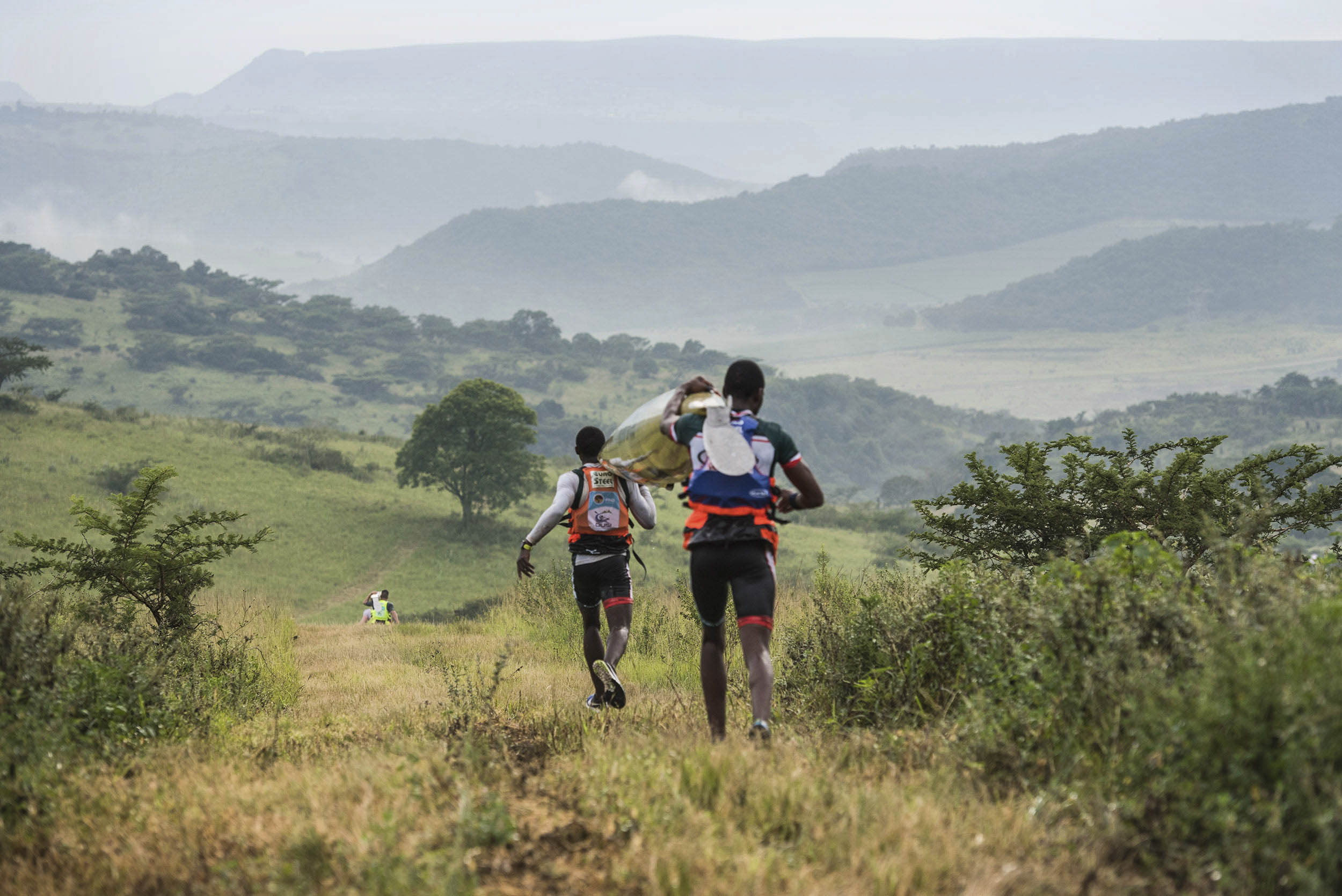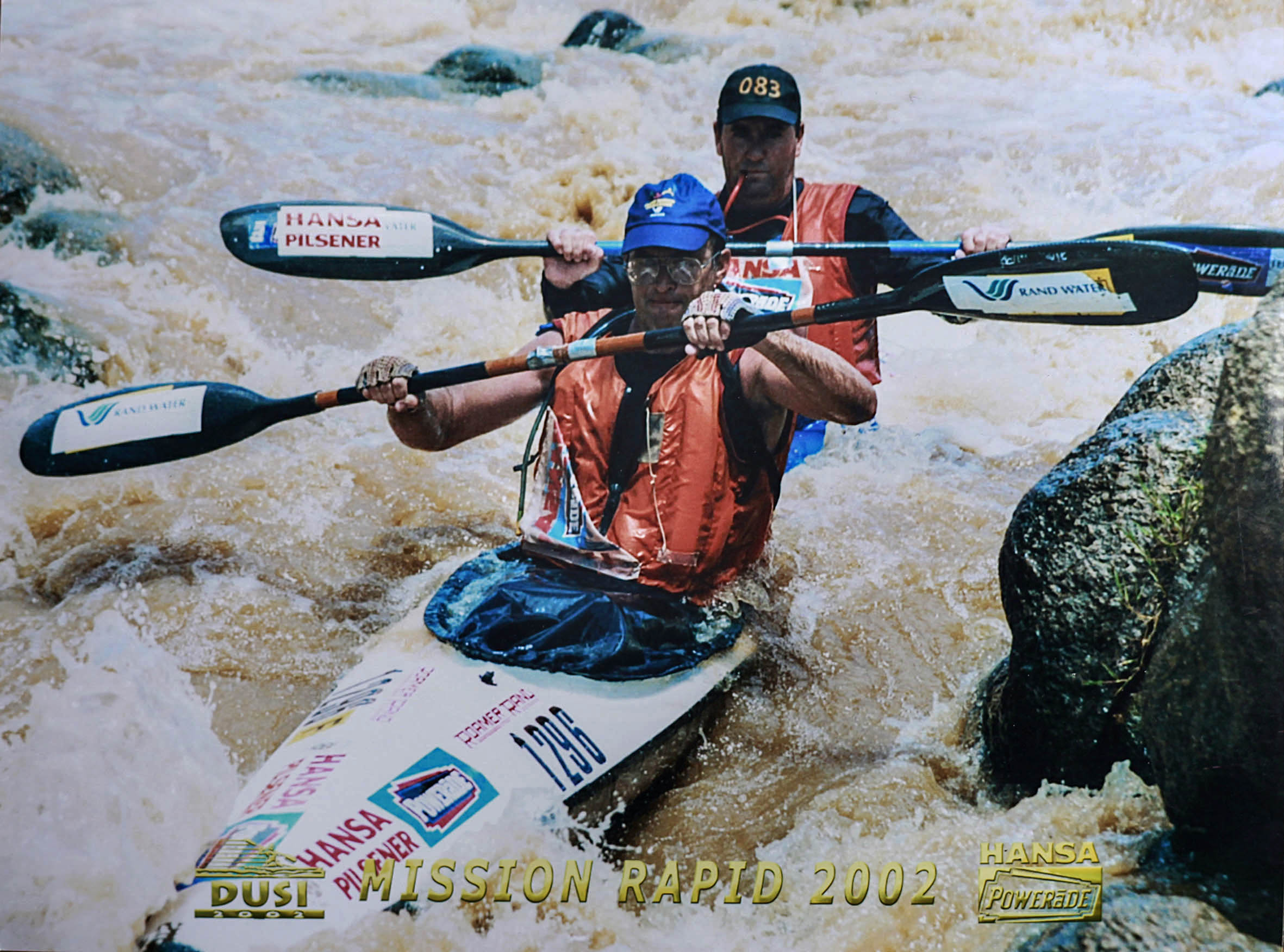Annual ritual: The Dusi can present racers with a full-flowing river, which means more rapids or low water levels. Photo: Gameplan Media
The Blue Lagoon, the mouth of the Umgeni River where it runs into the sea in Durban, was never blue when I visited it as a kid. The standout feature was a motorised boat made to look like a giant swan, which offered rides.
I don’t know how old I was but it seemed quite mysterious. We would hang around for a while and then, in the distance up the river, to some excitement, men would appear wearing black and paddling canoes.
As they got closer we could see they were wearing shoulder pads. They’d paddle up to where we spectators stood and celebrate by gulping down a bottle of milk. Such was my introduction to the Dusi.
But this did not mean that I took up paddling. KwaZulu-Natal, with innumerable rivers, is a great place to check out where the light comes to dance, as I once read rapids described, but it was only many years later, living in Johannesburg, that over a period of six months I’d get sufficiently stable at paddling a canoe around Emmarentia Dam.
Smaller rivers such as the Crocodile, which flows into the Hartebeespoort Dam, became my training ground to learn — through much trial and error — river technique, the way through the dancing, sometimes angry, water.
All rivers then led to the Dusi and in 1988 I signed up for this grand adventure. I realise now, decades later as I line up for my 30th medal, that one of my most enduring relationships has been with this river. For me, as with others, it is not a race but a pilgrimage, an annual trial of tribulation and celebration.
I missed one Dusi while living overseas, and did not finish one because my partner had severe dehydration, but otherwise I have annually completed this odyssey down the valleys of the Umzindusi and Umgeni.
Thirty finishes may seem a lot, but not in Dusi terms. The record, 47 medals, is held by Lyle Wheeler, who recently eclipsed Dusi deity and 15-time winner Graeme Pope-Ellis, who had 46 finishes when he was killed in a tractor accident in 2010. Ten paddlers have done more than 40 and 80 have completed 30 or more.
The paddling pilgrim will be there when the water is high — think floods — rollercoasting to the sea. In 2009 the river was particularly full. On day two, my partner Mike and I hugged the bank on the 400m Cascades rapid, navigating down seven or so mini waterfalls. A lifeguard watched us, Mike pointing out afterwards that the look on his face said he had no idea how he’d come to our rescue if needed.
The river can also be low. One time we ran out of water leaving Pietermaritzburg, which meant carrying our boats for most of the first and second days. In 2017 there was literally no water flowing out of the Inanda Dam near the start of day three. We portaged perhaps 20km before we found just enough water to float our boats. We pitch, though, whether the level is high or nonexistent. As my brother, David, who did 21 Dusis before hanging up his paddle, would say: “It is the same for everybody.”

The Dusi can present racers with low water levels, which means far longer distances of portage — otherwise known as carrying your canoe. Photo: Gameplan Media
But even if the river is full, you still carry probably for at least 15km over the three days on the 120km course. Portaging is allowed as a shortcut where, for instance, the river goes around a lazy bend, so you can pop over a hill and head directly back to the river again.
In one case, at the Saddles on day two, you rejoin the river after the first portage, paddle 50m or so upstream and then immediately portage again.
But there are other places where a portage would chop off a long section and where you are not allowed to get out of the river. This is the Dusi, a curious mix of what makes sense and what is tradition. You don’t question, you follow the rules. There are endless rapids — some fearsome — as well as man-made obstacles such as weirs and bridges to contend with. Work with the water, glide through the rapids while avoiding the rocks and you’re in adrenaline heaven. But don’t get it right, and a nasty swim (paddlerspeak for capsizing), bouncing over rocks or a broken boat can result.
The Dusi can be done solo (in a K1) or, sometimes testing a friendship or relationship, in a double (a K2). K2s are more stable and easier to carry because the K1 can be more easily caught by the wind and in trees while portaging. I prefer doubles paddling, as the Dusi is best as a shared experience, and I’ve have done four each with my former wife Lucille and son Dillon (who then hung up his paddle and converted to the important job of seconding), as well as three with my partner, Lynn.

Solo or duo: Kevin Davie (in the front of the double canoe, known as a K2) says he prefers doubles paddling, but this year he is heading out in a K1, his new Velox Fuse. Photos: Gameplan Media
Tensions can run high in the boat. My first partner, Dave, jumped out of the boat in one rapid after we hit a stopper, leaving me to fend for myself. By the third day he was anything but at ease.
“Should we shoot this next rapid?” I asked as we approached Colorado, then a reasonable rapid, which now is much less of a challenge.
“No,” he replied, “and don’t ask me!”
In 2017 I found myself for the first time after eight years in a single, doing more swimming than usual as I adjusted to the twitchiness of the K1. On the second day I ended up side-on in a rapid, with a short portion of my boat sticking into the mainstream. A K2 still somehow managed to smash into me, breaking it in two.
I taped up the damage but knew the repair would not survive even one rapid, so portaged many exceedingly hot kilometres until I found a spectator who had a fibreglass repair kit. I patched and then carried, as the resin hardened, to the beginning of the Inanda Dam, from where I could paddle to the overnight stop.
Last year I bought myself a new K1, the Velox Fuse. It is classed as intermediate in stability, with a voluminous top deck that gives really good buoyancy. I can’t stop marvelling at it. It loves the rapids, seems to have a mind of its own and is considerably better than me in taking on the big water: I just follow its lead. Heat is a major hazard. Conditions can be sweltering, you can be dripping sweat just sitting on the bank waiting for your start. It seldom rains, but when it does the footpaths on the portages become muddy, even treacherous.
One wet year, in a seemingly vertical climb out of the Devil’s Cauldron on day one, Lynn and I were stuck on a mud bank with few holds to find any purchase. It felt like we were on a climbing wall at a gym that we had to ascend with the boat, but without ropes. Two paddlers came to help Lynn in the front to get the boat up and out from where it was stuck.
Other boats are also a hazard. They can snarl up rapids, or, in some cases, knock you off your chosen line.
There is also the infamous Dusi guts, which can produce an explosive stomach. Paddlers will give the sage but obvious advice on how to deal with this threat: keep your mouth closed. This has worked for me and my sole bout of an afflicted stomach was the day after one finish.
The river changes continually. Rapids form and go away. Floods can destroy rapids, which take years to reform. At high levels, the rocks covered, some rapids are hardly there, but equally, a full river may mean you will have to be able to deal with big stoppers and broken waves.
The valley has changed from being poorly serviced with, for example, electricity under apartheid, so that the night was largely dark. Today thousands of lights twinkle from homes on the hillsides.
Security was an issue back then, with some of the areas featuring in South African Police “unrest” reports. Paddlers in some cases suffered harassment, usually low-key stuff such as having your cap taken off your head as a souvenir, but I remember one Dusi paddling past a Casspir with a mounted machine gun at hand.
The late Robert Lembethe, a 17-time finisher, established a canoe club at Nagle Dam, persuading youngsters who played football there to switch to paddling. His protégés now include some of the biggest names in canoeing and are well represented, especially at the front of the race.
Canoeing is not without its dangers, most notably foot entrapment, when your foot can get caught between rocks, the fast water preventing escape. If you capsize, you should only try to stand if you capsize once you are out of the rapid. Entrapment in a boat is also possible. The fibreglass can quickly wrap if side-on against a rock in fast water. In this kind of situation you need to get out of the boat quickly.
There have been three drownings that I am aware of in the time I have been doing the race, but canoeing has a strong safety consciousness and lifeguards are present at the more challenging Dusi rapids. Canoeists say that you are more likely to come to grief driving to the event than participating, and although this may not be not true, it does capture the sentiment paddlers associate with the event.
For the pilgrim the Dusi is much more than a sporting fixture. It is a rite of passage, a ritual that must be repeated annually.
But pilgrims are typically unarmed. And the Dusi can seem gladiatorial, a battle, with canoe and paddle as weapons, against everything it throws at you. It is hard, but underpinning all is a celebration, a dance where light and river meet.